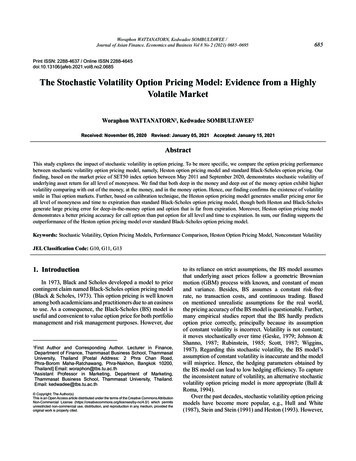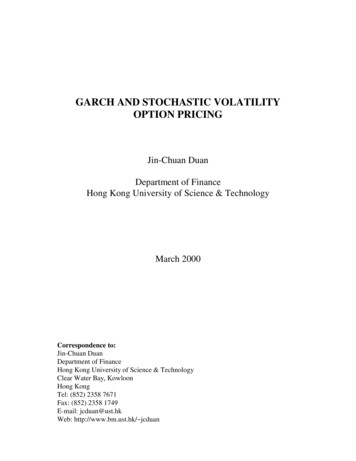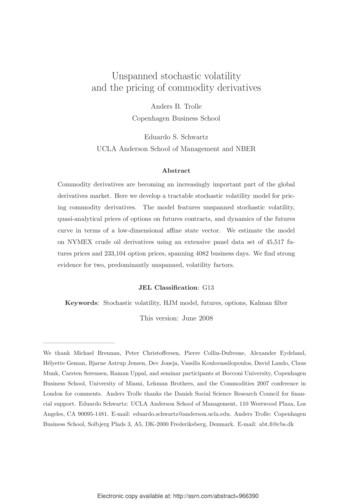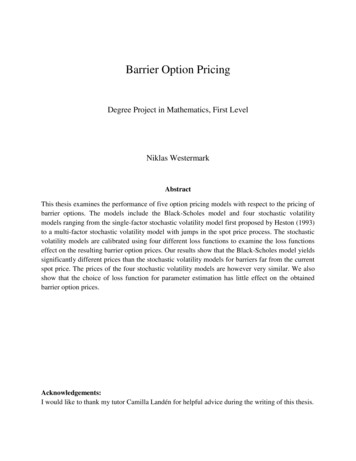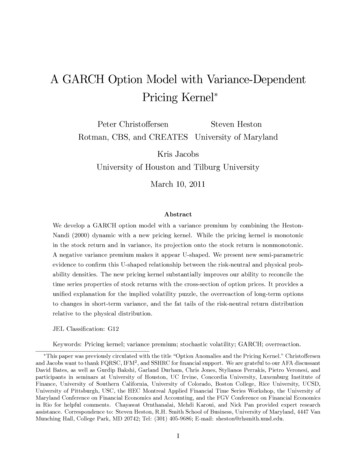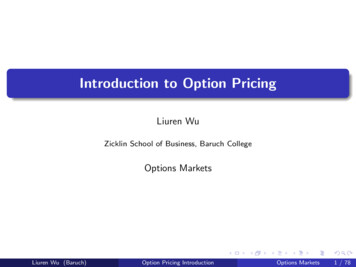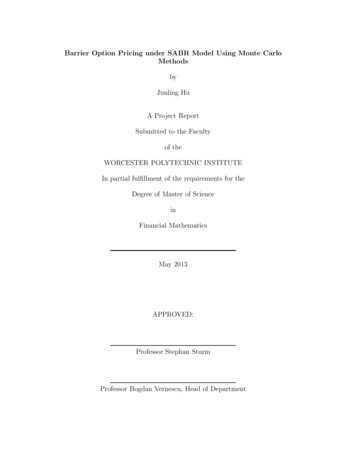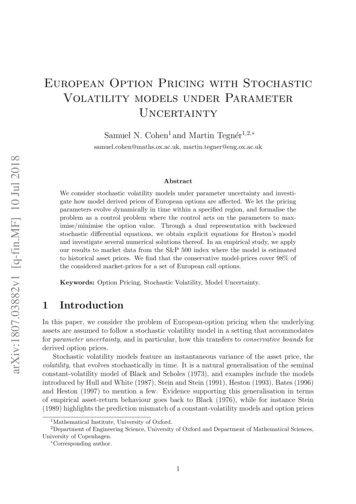
Transcription
European Option Pricing with StochasticVolatility models under ParameterUncertaintySamuel N. Cohen1 and Martin Tegnér1,2, arXiv:1807.03882v1 [q-fin.MF] 10 Jul 2018samuel.cohen@maths.ox.ac.uk, martin.tegner@eng.ox.ac.ukAbstractWe consider stochastic volatility models under parameter uncertainty and investigate how model derived prices of European options are affected. We let the pricingparameters evolve dynamically in time within a specified region, and formalise theproblem as a control problem where the control acts on the parameters to maximise/minimise the option value. Through a dual representation with backwardstochastic differential equations, we obtain explicit equations for Heston’s modeland investigate several numerical solutions thereof. In an empirical study, we applyour results to market data from the S&P 500 index where the model is estimatedto historical asset prices. We find that the conservative model-prices cover 98% ofthe considered market-prices for a set of European call options.Keywords: Option Pricing, Stochastic Volatility, Model Uncertainty.1IntroductionIn this paper, we consider the problem of European-option pricing when the underlyingassets are assumed to follow a stochastic volatility model in a setting that accommodatesfor parameter uncertainty, and in particular, how this transfers to conservative bounds forderived option prices.Stochastic volatility models feature an instantaneous variance of the asset price, thevolatility, that evolves stochastically in time. It is a natural generalisation of the seminalconstant-volatility model of Black and Scholes (1973), and examples include the modelsintroduced by Hull and White (1987), Stein and Stein (1991), Heston (1993), Bates (1996)and Heston (1997) to mention a few. Evidence supporting this generalisation in termsof empirical asset-return behaviour goes back to Black (1976), while for instance Stein(1989) highlights the prediction mismatch of a constant-volatility models and option prices1Mathematical Institute, University of Oxford.Department of Engineering Science, University of Oxford and Department of Mathematical Sciences,University of Copenhagen. Corresponding author.21
observed from the market. Stochastic volatility serves as an attractive alternative andnumerous studies are available from the literature in their favour.Being a parametric model immediately implies that the stochastic volatility model hasto be fitted with data before it is employed for pricing or hedging market instruments. Atleast two approaches are conventional for this purpose: either estimation from historicalasset-prices, or calibration from market option-prices by matching the model derived price(or a combination of the two, see for example Aı̈t-Sahalia and Kimmel (2007)). Regardlessof which approach is used, one is exposed to parameter uncertainty since point-estimatesfrom either are subject to errors. An estimator based on observed time-series of assetprices has an inherent variance (and could potentially be biased), while the calibrationproblem might be ill-posed—the minimum obtained from numerical optimisation can belocal, and several parameter settings might give the same model-to-market matching.A concept of parameter uncertainty naturally arises with statistical estimation fromasset-prices since the error of the point-estimate can be quantified by an inferred confidence interval. The confidence interval thus defines an uncertainty set which containsthe true value of the model parameters, at a given confidence level. In this case, inferreduncertainty and estimated parameters will be associated with the real-world probabilitymeasure, as opposed to the risk-neutral measure(s) used for no-arbitrage pricing. Onthe other hand, calibration from option-prices will give a set of parameters associatedwith the risk-neutral measure. In this case, however, there is no obvious way of how todeduce an uncertainty set for the parameters which quantifies the errors that stem fromthe calibration.The question remains how the parameter uncertainty affects option prices as outputted by the stochastic volatility model. In the case of statistical estimation, one needsto establish the relation between the parameters under the statistical measure and undera risk-neutral pricing measure. In financial terms, this is accommodated by the marketprice of risk, and typically in such a way that the model remains form-invariant. Theuncertainty may then be propagated to the risk-neutral parameters which are used foroption pricing. We consider uncertainty in drift- and jump parameters1 to offer an interpretation of the parameter uncertainty as representative for the incompleteness of thestochastic volatility model: there exists a space of equivalent pricing measures as givenby the span of risk-neutral parameter values in the uncertainty set (we elaborate on thisin the introducing discussion of Section 3).We immediately look at the model pricing from a best/worst case point of view, andaim to obtain conservative pricing bounds inferred from the parameter uncertainty. Twoapproaches are fair: either optimising the pricing function over the parameters constrainedby the uncertainty set, or treating the parameters as dynamical components of a controlprocess which acts to optimise the option value. The former is thus a special case of thelatter where the control process is restricted to take constant values only. We formalisethe problem as a control problem and since all pricing measures are equivalent, this canbe seen as change of measure problem. Following the results due to Quenez (1997), theoptimal value function of the option price may then by expressed as a backward stochasticdifferential equation.1A supporting case for this assumption is the fact pointed out for instance by Rogers (2001): whilevolatilities may be estimated within reasonable confidence with a few years of data, drift estimationrequires data from much longer time periods.2
The postulation of parameter uncertainty, or more generally model uncertainty, asan inherent model feature is certainly not novel and its importance in finance was earlyacknowledged by Derman (1996). Conceptually, model uncertainty draws on the principles due to Keynes (1921) and Knight (1921) of the unknown unknown as distinguishedfrom the known unknown. Following the overview by Bannör and Scherer (2014), modeluncertainty—the unknown unknown—refers to the situation when a whole family of models is available for the financial market, but the likelihood of each individual model isunknown. Parameter uncertainty is thus the special case where the family of models maybe parametrized. Further, if a probability measure is attributed to the model (parameter)family—the known unknown—one is in the situation of model (parameter) risk.When it comes to option pricing, Bayesian methods offer a fruitful way of inferringparameter and model risk, and take it into account by model averaging, see for exampleJacquier and Jarrow (2000), Bunnin et al. (2002), Gupta et al. (2010) and the nonparametric approach to local volatility by Tegnér and Roberts (2017). Considering thesituation of model uncertainty, the worst-case approach taken here was pioneered in theworks of El Karoui and Quenez (1995), Avellaneda et al. (1995), Lyons (1995) and Avellaneda and Paras (1996). Our control-theoretic approach is similar to that of Avellanedaet al. but in contrast to their unspecified volatility, we place ourself in a “within-model”setting of parametrised volatility models where the parameters are controlled instead ofthe volatility itself. We thus account for a case where the uncertain family of volatilitymodels gives a more detailed description of the financial market. Arguably, this implies conservative prices which are more realistic. Since we also suggest how to infer theuncertainty set for the parameters, our approach should be particularly appealing forstochastic-volatility inclined practitioners.Overview. The model proposed by Heston (1993) will be the working model of ourstudy, and we present the risk-neutral pricing of European options in Section 2 alongwith the BSDE representation of the controlled value process. We show how to derivethe optimal driver that generates the BSDE of the optimally controlled value processes,which gives us the pricing bounds for options under parameter uncertainty. To obtainactual values for the pricing bounds, we must resort to numerical solutions for the BSDEthat governs the optimal value. In Appendix A, we detail some simulation schemes forthis purpose, and demonstrate the methods in a controlled setting to be able to compareand evaluate their performance. With a suggested numerical scheme in hand, we proceedin Section 3 to illustrate our method empirically on real-world market data. For a setof market quotes of European call options on the S&P 500 index, we investigate howwell the (numerically calculated) model bounds actually cover observed market prices.We also compare the results with the corresponding constant-parameter optimal price.For completion, we finally treat the general multi-asset case of a Markovian stochasticvolatility model with jumps in Section 4. Section 5 concludes.2The Heston stochastic volatility modelTo set the scene, we consider a financial market consisting of a risk-free money accountand a risky asset over a fixed time period [0, T ]. We assume the standard assumptionsof a frictionless market: short selling is permitted and assets may be held in arbitrary3
amounts, there are no transaction costs and borrowing and lending are made at the sameinterest rate. The prices of the assets will be modelled as adapted stochastic processes ona filtered probability space, the notion of which will be formalised in the following section.2.1European option pricingLet (Ω, F, {Ft }t 0 , P ) be a filtered probability space where {Ft }t 0 is the natural filtrationgenerated by two independent Wiener processes W 1 and W 2 , augmented to satisfy theusual conditions of P -completeness and right continuity. We assume that the asset priceS and variance V follow the model by Heston (1993), with real-world dynamics (underthe objective probability measure P ) given byppdSt µ(Vt )St dt Vt St (ρdWt1 1 ρ2 dWt2 ),pdVt κ(θ Vt )dt σ Vt dWt1 ,for nonnegative constants κ, θ, σ and instantaneous correlation ρ ( 1, 1). The varianceprocess thus follows a square root process2 and it is bounded below by zero. If Feller’scondition is satisfied, 2κθ σ 2 , the boundary cannot be achieved. Furthermore, therelative rate of return µ is taken to be a deterministic function of the variance. In additionto the risky asset, the market contains a risk-free money account which value processesis denoted B. The money account pays a constant rate of return r, which means that Bobeys the deterministic dynamics dBt rBt dt.The market price of risk processes (γ 1 , γ 2 ) associated with W 1 and W 2 are assumedto be specified such that µ(V ) r 1 p22 ργ 1 ρ γ(1)V and as suggested by Heston, we let γ 1 λ V for some constant λ.3 We then have thatthe stochastic exponential of (γ 1 , γ 2 ) (W 1 , W 2 ) is given by4 Z . pZ .Z1 . 2122 22(λ Vs (γs ) )dsλ Vs dWs γs dWs E( γ W ) exp 2 000and if we define the measure Q on FT for a fixed deterministic time T bydQ E( γ W )TdPwe have that Q is equivalent to P (provided the stochastic exponential is a martingale,i.e. E[E( γ W )t ] 1 for all t [0, T ], for which Novikov’s and Kazamaki’s conditions2Also know as a CIR process from its use as a model for short-term interest rates by Cox et al. (1985).The square root process goes back to Feller (1951).3Heston motivates this choice from the model of Breeden (1979) under the assumption that theequilibrium consumption process also follows a square-root process; the risk premium is then proportionalto variance. Aggregate risk preferences aside, a consequence is that the pricing equation (3) convenientlyallows for Heston’s pricing formula.Pd R .4We use to denote the stochastic integral of d-dimensional processes: H M i 1 0 Hti dMti forH, M taking values in Rd .4
are sufficient. Wong and Heyde (2006) express this explicitly in terms of the parameters).Further, by the Girsanov theorem, {W̃t1 }t [0,T ] and {W̃t2 }t [0,T ] defined bypdW̃t1 λ Vt dt dWt1 ,dW̃t2 γt2 dt dWt2 ,are independent Wiener processes under Q. By virtue of equation (1), this gives theQ-dynamics of the modelppdSt rSt dt Vt St (ρdW̃t1 1 ρ2 dW̃t2 ),p(2)dVt (κθ [κ σλ] Vt ) dt σ Vt dW̃t1 ,for t [0, T ] and we note that the variance dynamics are form invariant under the measurechange: V also follows a square root process under Q with “risk-neutral” parameters κ̃, θ̃, σwhereκθ.κ̃ κ σλ and θ̃ κ σλWe also see that the discounted asset price B 1 S will be a Q-martingale (i.e. Q is anequivalent martingale measure) such that the financial market model (B, S) is arbitragefree. However, as (γ 1 , γ 2 ) may be arbitrarily chosen as long as (1) is satisfied, the modelis incomplete. This means that λ could be determined by a single exogenously given asset(with a volatility dependent price) to complete the market, and γ 2 is uniquely determinedby equation (1). Any other contingent claim will then be uniquely priced.For a European option with payoff g(ST ) at maturity T , we have that the C 1,2 functionD(t, s, v) of the pricing rule Dt D(t, St , Vt ), t [0, T ], for the option satisfies thefollowing partial differential equation D D D 1 2 2 D 2D1 2D rs {κθ v(κ σλ)} s v 2 ρσvs σ 2 v 2 rD, t s v2 s v s 2 v(3)with terminal condition D(T, s, v) g(s). Notice that the expression in curly bracketscan be equivalently written κ̃(θ̃ v) with the risk-neutral specification of the parameters.Equivalently, by Feynman–Kac, this is to say that we have the usual risk-neutral pricingformula D(t, s, v) EQ e r(T t) g(ST ) (St , Vt ) (s, v)where (S, V ) follows the Q-dynamics with initial value (St , Vt ) (s, v) at the initial timet [0, T ].The pricing equation (3) is the same as in Heston’s original paper if we let λv σλand λ(t, St , Vt ) λv Vt the price of volatility risk used in his exposition. The equation issolved by considering the Fourier transform of the price and the resulting “semi-closed”pricing formula is obtained by the inverse transform. In practice, however, the inversetransform has to be calculated by numerical integration methods.2.2Conservative pricing under parameter uncertaintyHeston’s model (and any other stochastic volatility model) is fundamentally a modelfor the underlying financial market even if it is predominantly used for option pricing5
purposes. The pricing measure is often taken as being fixed for convenience, for instancethrough model-to-market calibration of option prices, and the connection to the objectivemeasure is not important for the analysis; and hence not necessarily made explicit.Although we are dealing with option pricing as well, we take a slightly converse approach in the case when the pricing measure inherits its uncertainty from the objectivemeasure. Here we infer uncertainty of pricing parameters from statistical estimation ofobjective parameters, and the relation between the measures will thus play an integralrole. On the other hand when uncertainty is deduced from a calibration method of pricingparameters directly, there is no need to make an explicit connection between the measures.We will handle both cases simultaneously and for this purpose, we assume a pricing measure Q to be given momentarily just to be able to replace it with another pricing measurethat is subject to uncertainty.To this end, we introduce parameter uncertainty in our model by modifying our referencemeasure with the effect of a control that governs the parameter processes. Namely, wereplace the risk-neutral measure Q with an equivalent measure Qu under which we havethe controlled dynamicsppdSt ru (ut )St dt Vt St (ρdWtu1 1 ρ2 dWtu2 ),p(4)dVt κu (ut ) (θu (ut ) Vt ) dt σ Vt dWtu1 ,for t [0, T ]. The control process {ut }t 0 is an Ft -predictable process that takes values ina compact set U R3 , which we will call the parameter uncertainty set. We write U forthe space of admissible control processes (that is, predictable processes taking values in Uwith sufficient integrability) and under Qu , we have that W u1 and W u2 are independentWiener processes, as will be explained in a moment. The control process realises its pathsstochastically, and we simply do not know beforehand which {ut }t 0 U will be governing(4): the uncertainty is tantamount to this choice.Furthermore, we denote the components of the control {ut }t 0 {rt , κt , θt }t 0 and letthe controlled drift-functions of (4), all f : U R , be defined asru (ut ) rt ,κu (ut ) κt σλ and θu (ut ) κt θt.κt σλ(5)Notice that this specification of the controlled drift relies on the premise that the Qparameters r, κ̃, θ̃ are subject to parameter uncertainty by their replacement with ru , κu , θu .The uncertainty is in turn taken to be inferred from statistical estimation of the objectiveP -parameters, represented by (rt , κt , θr ) U where U is the statistical uncertainty set,and transferred to the pricing parameters by the mapU 3 ut 7 (ru (ut ), κu (ut ), θu (ut )) U λas given by (5). Here U λ is the uncertainty set for the controlled parameters, induced bythe same mapping. The parameter λ associated with Q thus plays an instrumental rolein facilitating the uncertainty transfer and it determines the set U λ where our uncertainprice-parameters live. In practice, we forcefully set λ 0 to obtain that the uncertaintyin price-parameters is exactly that of the uncertainty in estimated real-world parameters,i.e. U λ U . However, note that this does not imply P Q nor µ r, cf. equation (1).6
Similarly, when a calibration approach is employed to give pricing parameters and anassociated uncertainty set directly, the identitiesru (ut ) rt ,κu (ut ) κt ,θu (ut ) θt(6)will facilitate the replacement of r, κ̃, θ̃ with the control (rt , κt , θt ) U , now representinguncertain pricing parameters restricted to lie within a risk-neutral uncertainty set U .5With the controlled dynamics of (S, V ) representing the model under influence of parameter uncertainty, we proceed to define what we mean with the upper and lower boundaryfor the price of a European option. Namely, for an option written on S with terminalpayoff at time T given by a square-integrable FT -measurable random variable G, we willtake the most conservative prices from valuation under the controlled pricing measures(i.e. under parameter uncertainty) as given by the control problemsh RTih RTiDt ess inf Eu e t rs ds G Ftand Dt ess sup Eu e t rs ds G Ft(7){u } U{ut } Utfor t [0, T ], where Eu (· F) denotes the conditional expectation under Qu . In a sense,we thus consider the super-replication costs of selling a long/short position in the optionwhen the uncertain parameters evolve stochastically in the uncertainty set, in an optimalway.6In order to find a pricing PDE that corresponds to equation (3) of the previous section,we henceforth consider payoffs given by G g(ST ) for some non-negative function g. Dueto the Markovian structure of the problem, we then have that the optimal value processeswill be functions of the current asset price and variance stateDt D (t, St , Vt ),Dt D (t, St , Vt ),for some continuous functions D : [0, T ] R R R. As we will see later, thesefunctions will satisfy a semilinear version of the standard pricing equation for Europeanoptions. However, before we arrive at more precise expressions for the optimally controlledvalue processes (and their generating functions) we take one step backwards: we willfirst consider the value process for a fixed control and its link to a backward stochasticdifferential equation. Following the approach due to Quenez (1997) as outlined in Cohenand Elliott (2015), we then consider the optimally controlled value process as the solutionto a closely related BSDE.With the intention of finding the pricing-boundaries through a dual formulation withBSDEs, we begin by considering the following representation from Girsanov’s theoremdWt1u dW̃t1 α1 (t, St , Vt )dt,dWt2u dW̃t2 α2 (t, St , Vt )dt.5(8)Here we could be a bit more finical on notation, for instance with (rt , κ̃t , θ̃t ) Ũ representing thepricing uncertainty deduced from calibration. For brevity, we refrain from such a notional distinction.6This draws on the interpretation that {Qu : u U } is the set of equivalent martingale measuresof an incomplete market model, such that the most conservative risk-neutral price of an option equalsthe super-replication cost of a short position in the same: with Πt (G) inf φ {Ṽt (φ) : VT (φ) G, a.s.}being the discounted portfolio value of the (cheapest) admissible strategy φ that super-replicates G, thenΠt (G) ess supu U Eu [G̃ Ft ] and the supremum is attained. See for instance Cont and Tankov (2004),Section 10.2.7
For its kernel α (α1 , α1 ) , straightforward algebra then shows that uuuκ(u)θ(u) κ̃θ̃ (κ(u) κ̃)Vtttt1α(St , Vt , ut ) ρ(κu (ut )θu (ut ) κ̃θ̃ (κu (ut ) κ̃)Vt ) σ(rt r) σ Vt1 ρ2(9)ties together the dynamics (4) and (2) associated with W u and W̃ , respectively. Formally,if the stochastic exponential of the process α(S, V, u) (W̃ 1 , W̃ 2 ) defines the measurechange Q Qu on FT , Z .Z .dQu21,α2 (St , Vt , ut )dW̃t Eα1 (St , Vt , ut )dW̃t dQ00T(provided E(α W̃ ) is a martingale), then W 1u and W 2u defined in (8) are two independent Wiener processes under Qu by Girsanov’s theorem.Next, we define the linear driver function f : (0, ) (0, ) R R1 2 U R asf (s, v, y, z, u) %(s, v, u)y zα(s, v, u)(10)where %(s, v, u) r, that is, the (negative) first component of the control which represents the risk-free interest rate. With the driver defined by (9)-(10), we then obtain thefollowing representation of the expected value under Qu : for a given, fixed control processu {ut }t 0 U, the controlled value process given byh RTi t rs dsJt (u) Eu eg(ST ) Ft , t [0, T ],is the unique solution to the linear Markovian backward stochastic differential equationdJt (u) f (St , Vt , Jt (u), Zt , ut )dt Zt dW̃t ,JT (u) g(ST ),(11)where Z (Z 1 , Z 2 ) —the martingale representation part of J(u)—is a process takingvalues in R1 2 (being a part of the solution to the BSDE). To see this, consider the processJ(u) that solves (11) and let E(Γ) be the stochastic exponential ofZ .Z . rt dt α(St , Vt , ut ) dW̃t .Γ 00Apply Itô’s product rule to E(Γ)J(u) to obtain d (E(Γ)t Jt (u)) E(Γ)t Zt Jt (u)α(St , Vt , ut ) dW̃tand thus, since E(Γ)J(u) is a martingale under Q, we have1EQ [E(Γ)T g(ST ) Ft ]E(Γ)th RTiRt1rs dsQ 0 rs ds 0 eE eE(α W̃ )T g(ST ) FtE(α W̃ )th RTi Eu e t rs ds g(ST ) FtJt (u) 8
as E(α W̃ ) is the density for the measure change Q Qu .The BSDE (11) governs the value process under the impact of a fixed parameter controlprocess that evolves in the uncertainty set U . To obtain the lowest (highest) value scenario,the value process is to be minimised (maximised) over all admissible controls in U, andas we detail in the following, this is done through pointwise optimisation with respect tou U of the driver function for the value process. Hence, we define the following driversoptimised over the parameter uncertainty setH (s, v, y, z) ess inf f (s, v, y, z, u) and H (s, v, y, z) ess sup f (s, v, y, z, u),u Uu Uwhere we note that as U is compact, the infimum and supremum are both attained. Wethen have the following main result which is due to the comparison principle for BSDEs:the lower/upper optimally controlled value processesDt ess inf Jt (u) and Dt ess sup Jt (u)u Uu Ufor t [0, T ], have cadlag modifications that are the unique solutions of the BSDEsdDt H (St , Vt , Dt , Zt )dt Zt dW̃t ,DT g(ST ).(12)In particular, the processes are equal to deterministic functions of (t, St , Vt ), that is,Dt D (t, St , Vt ) for some continuous functions D : [0, T ] R R R. As theinfimum (supremum) of H is attained, we further have that there exists optimal controls{u t }t [0,T ] U which are feedback controls. This means that the processes u t u (t, St , Vt ),t [0, T ],are the optimal controls among all predictable controls for some deterministic functionsu : [0, T ] R R U . Finally, by the semilinear Feynman-Kac formula (provided asolution exists), we have that D (t, s, v) satisfies the following semilinear parabolic PDE 2D1 2D D 1 2 2 D s v 2 ρσvs σ2v 2 t2 s v s 2 v D Duu ess inf rD rs κ (κ) (θ (θ) v) 0(r,κ,θ) U s v(13)with terminal value D (T, s, v) g(s). In the corresponding equation for D (t, s, v) wehave a supremum substituted for the infimum.Proof: For the first part of the result, since H (s, v, y, z) f (s, v, y, z, u) by definition,we have that the (unique) solution7 Y to the BSDE with data (g(ST ), H ) satisfies Yt Jt (u) for all controls u U (up to indistinguishability). This is a consequence of thecomparison theorem for BSDEs (Peng (1992), see also El Karoui et al. (1997)). Further,7As we assume the driver f to be sufficiently integrable for the J(u)-BSDE to admit a unique solution(i.e. it is a stochastic Lipschitz driver) the integrability carries over to H such that the Y -BSDE admitsa unique solution as well.9
by Filippov’s implicit function theorem (Beneš (1970), see also McShane and Warfield(1967) and Filippov (1959)), for each 0 there exists a predictable control u Usuch that f (s, v, y, z, u ) H (s, v, y, z) . Since Yt (T t) solves the BSDE withdriver H (s, v, y, z) , the comparison theorem yields Jt (u ) Yt (T t) (up toindistinguishability) and we have the inclusionYt Jt (u ) Yt (T t).Letting 0 we have that Yt ess inf u U Jt (u) Dt for every t which is to say thatY is a version of the optimal value process. That Dt can be written as a continuousfunction of (t, St , Vt ) is due to the fact that (12) is a Markovian BSDE. Further, as wehave that the optimal control is attainable, Filippov’s theorem gives that it is a functionof (t, St , Vt , Dt , Zt ) where Zt z(t, St , Vt )—due to the Markovian BSDE8 —and we have the result that u t u (t, St , Vt ) for a deterministic function.To obtain an expression for the optimised driver H , we note that the driver of the valuefunction is conveniently expressed in terms of divergence of the controlled drift from theoriginal parameters; by rearrangement of (10)f (St , Vt , Yt , Zt , ut ) (rt r)u!Zt2p Yt1 ρ2 V tu (κ (ut )θ (ut ) κ̃θ̃)u (κ (ut ) κ̃)Zt1ρZt2 p σ Vtσ 1 ρ2 Vt ! Zt1 VtρZt2 Vt pσσ 1 ρ2(14) rYt .(15) ! Zt1 VtρZt2 Vt pσσ 1 ρ2(16)!Alternatively, this can be expressed asf (St , Vt , Yt , Zt , ut ) (rt r)!Zt2p (κt θt κθ) Yt1 ρ2 V t (κt κ)ρZt2Zt1 p σ Vtσ 1 ρ2 Vt! rYt(17)since κu (ut ) κ̃ κt κ and κu (ut )θu (ut ) κ̃θ̃ κt θt κθ, which is due to the linearform of the drift (and the simple form of the parameter change under P Q, regardlessof the value of λ). If we let βt κt θt and use the parametrisation (rt , κt , βt ) 7 (rt , κt , θt ),we thus have that the driver is a linear function of the divergenceũt (rt r, κt κ, βt β).Hence, the optimal drivers H are obtained by minimising/maximising a linear objectivesubject to the constraint given by the compact uncertainty set U —equation (16) in caseof statistical uncertainty for P -parameters, or similarly, (14) with the identities (6) whendealing with Q-parameters under uncertainty deduced from calibration.8The function for the martingale representation Z is obtained explicitly by applying Itô’s lemma toDt D(t, St , Vt ) and using the semilinear pricing PDE (13), which givesdD(t, St , Vt ) H(St , Vt , Dt , Zt )dt x D(t, St , Vt )σ(St , Vt )dW̃twhere x f ( s f, v f ) and σ(s, v) should be understood as the diffusion matrix of (2). Hence, byuniqueness of the BSDE solution, z(t, s, v) x D(t, s, v)σ(s, v) is the deterministic generating functionfor Z.10
To this end, we consider elliptical uncertainty sets as given by the quadratic form U u : ũ Σ 1 ũ χfor some positive semi-definite matrix Σ and positive constant χ. In particular, fromstatistical inference, we have that the 1 α confidence ellipse2ũ Σ 1r,κ,β ũ χ3 (1 α)(18)represents u U (for a significance level α) where Σr,κ,β is the covariance matrix of theparameters and χ23 (1 α) is the quantile of the chi-squared distribution with three degreesof freedom (see further Section 3.1). The formal justification for elliptical uncertainty setsis that (18) is a level set of the asymptotic likelihood, due to large-sample normality of themaximum likelihood estimator of the parameters. This is the same form of uncertaintyas given by the confidence region under Wald’s hypothesis test, and approximates theoptimal confidence set, by Neyman–Pearson lemma (see Lehmann and Romano (2006)).As ũ 7 f (ũ) is linear, it has no internal stationary points and the quadratic problemsH inf f (ũ) and H sup f (ũ)subject to ũ Σ 1 ũ χgive the optimised drivers. The solutions are (obtained e.g. by a Lagrange multiplier)q H (St , Vt , Zt , Yt ) χ n t Σ nt rYtr(19)χ Σnũ (St , Vt , Zt , Yt ) t n t Σ ntwhere nt is the 3 1 vector of coefficients to the parameter deviances of equation (16)given by!!# " ! Zt1 VtρZt2 VtZt1ρZt2Zt2p p p,.nt Yt , σσ Vt σ 1 ρ2 Vt1 ρ2 Vtσ 1 ρ2The optimal drivers in (19) conclude our analysis since we now have an explicit formfor the stochastic differential equation (12) that describes the evolution of the pricingboundaries. Before we proceed to obtaining approximat
Keywords: Option Pricing, Stochastic Volatility, Model Uncertainty. 1 Introduction In this paper, we consider the problem of European-option pricing when the underlying assets are assumed to follow a stochastic volatility model in a setting that accommodates for parameter uncertainty, and in particular, how this transfers to conservative bounds for
